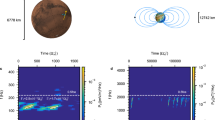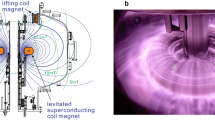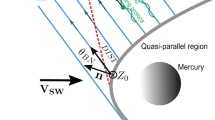Abstract
Whistler-mode chorus waves are natural electromagnetic emissions known to play a key role in electron acceleration and loss mechanisms via wave–particle interactions in planetary magnetospheres. Chorus waves have not yet been detected in Mercury’s magnetosphere due to the lack of suitable instruments in the probes that previously visited the planet as well as to its harsh environment. Here, we present the direct probing of chorus waves in the localized dawn sector during the first and second Mercury flybys by the BepiColombo/Mio spacecraft. Mio’s search coil magnetometers detected chorus events with tens of picotesla intensities in the dawn sector, while no clear chorus activity was observed in the night sector. The simulation results suggest that this regional difference could be due to the impact of background magnetic field inhomogeneities on the nonlinear wave generation process. This observational evidence is crucial for understanding the energetic electron dynamics of the localized dawn sector of Mercury’s magnetosphere.
This is a preview of subscription content, access via your institution
Access options
Access Nature and 54 other Nature Portfolio journals
Get Nature+, our best-value online-access subscription
$29.99 / 30 days
cancel any time
Subscribe to this journal
Receive 12 digital issues and online access to articles
$119.00 per year
only $9.92 per issue
Buy this article
- Purchase on Springer Link
- Instant access to full article PDF
Prices may be subject to local taxes which are calculated during checkout



Similar content being viewed by others
Data availability
The spacecraft orbit data are available from SPICE data for BepiColombo https://www.cosmos.esa.int/web/spice/spice-for-bepicolombo. The PWI raw data are available from https://doi.org/10.5281/zenodo.8026227 (in a Zenodo repository). The PWI team (Yasumasa Kasaba, principal investigator; kasaba.y@tohoku.ac.jp) and the corresponding author can provide the PWI raw data upon reasonable request. Source data are provided with this paper.
Code availability
The particle-in-cell simulations are based on the literature36,45 and the PIC code (KEMPO1) is available at http://space.rish.kyoto-u.ac.jp/software/.
References
Baumjohann, W. et al. Current systems in planetary magnetospheres and ionospheres. Space Sci. Rev. 152, 99–134 (2010).
Tsurutani, B. T. et al. A review of Alfvénic turbulence in high-speed solar wind streams: hints from cometary plasma turbulence. J. Geophys. Res. Space Phys. 123, 2458–2492 (2018).
Baker, D. et al. An impenetrable barrier to ultrarelativistic electrons in the Van Allen radiation belts. Nature 515, 531–534 (2014).
Domingue, D. L. et al. Mercury’s atmosphere: a surface-bounded exosphere. Space Sci. Rev. 131, 161–186 (2007).
Ness, N. F., Behannon, K. W., Lepping, R. P., Whang, Y. C. & Schatten, K. H. Magnetic field observations near Mercury: preliminary results from Mariner 10. Science 185, 151–160 (1974).
Ogilvie, K. W., Scudder, J. D., Vasyliunas, V. M., Hartle, R. E. & Siscoe, G. L. Observations at the planet Mercury by the plasma electron experiment: Mariner 10. J. Geophys. Res. 82, 1807–1824 (1977).
Anderson, B. J. et al. The global magnetic field of mercury from MESSENGER orbital observations. Science 333, 1859 (2011).
Anderson, B. J., Johnson, C. L. & Korth, H. A magnetic disturbance index for Mercury’s magnetic field derived from MESSENGER magnetometer data. Geochem. Geophys. Geosyst. 14, 3875–3886 (2013).
Korth, H., Johnson, C. L., Philpott, L., Tsyganenko, N. A. & Anderson, B. J. A dynamic model of Mercury’s magnetospheric magnetic field. Geophys. Res. Lett. 44, 10,147–10,154 (2017).
Zhao, J. T. et al. Observational evidence of ring current in the magnetosphere of Mercury. Nat. Commun. 13, 924 (2022).
Baker, D. N. et al. Intense energetic electron flux enhancements in Mercury’s magnetosphere: an integrated view with high-resolution observations from MESSENGER. J. Geophys. Res. Space Phys. 121, 2171–2184 (2016).
Ho, G. C. et al. MESSENGER observations of suprathermal electrons in Mercury’s magnetosphere. Geophys. Res. Lett. 43, 550–555 (2016).
Lindsay, S. T. et al. MESSENGER X-ray observations of magnetosphere–surface interaction on the nightside of Mercury. Planet. Space Sci. 125, 72–79 (2016).
Lindsay, S. T. et al. MESSENGER X-ray observations of electron precipitation on the dayside of Mercury. J. Geophys. Res. Space Phys. 127, e2021JA029675 (2022).
Slavin, J. A., Imber, S. M. & Raines, J. M. In Magnetospheres in the Solar System (eds Maggiolo, R. et al.), 535–557 (American Geophysical Union, 2021); https://doi.org/10.1002/9781119815624.ch34
Dewey, R. M., Slavin, J. A., Raines, J. M., Baker, D. N. & Lawrence, D. J. Energetic electron acceleration and injection during dipolarization events in Mercury’s magnetotail. J. Geophys. Res. Space Phys. 122, 12,170–12,188 (2017).
Burton, R. K. & Holzer, R. E. The origin and propagation of chorus in the outer magnetosphere. J. Geophys. Res. 79, 1014–1023 (1974).
Tsurutani, B. T. & Smith, E. J. Postmidnight chorus: a substorm phenomenon. J. Geophys. Res. 79, 118–127 (1974).
Summers, D., Thorne, R. M. & Xiao, F. Relativistic theory of wave-particle resonant diffusion with application to electron acceleration in the magnetosphere. J. Geophys. Res. 103, 20487–20500 (1998).
Thorne, R. et al. Rapid local acceleration of relativistic radiation-belt electrons by magnetospheric chorus. Nature 504, 411–414 (2013).
Horne, R. et al. Gyro-resonant electron acceleration at Jupiter. Nat. Phys. 4, 301–304 (2008).
Woodfield, E. E. et al. Rapid electron acceleration in low-density regions of Saturn’s radiation belt by whistler mode chorus waves. Geophys. Res. Lett. 46, 7191–7198 (2019).
Omura, Y. et al. Formation process of relativistic electron flux through interaction with chorus emissions in the Earth’s inner magnetosphere. J. Geophys. Res. Space Phys. 120, 9545–9562 (2015).
Allison, H. J., Shprits, Y. Y., Zhelavskaya, I. S., Wang, D. & Smirnov, A. G. Gyroresonant wave-particle interactions with chorus waves during extreme depletions of plasma density in the Van Allen radiation belts. Sci. Adv. 7, eabc0380 (2021).
Kurth, W. S. & Gurnett, D. A. Plasma waves in planetary magnetospheres. J. Geophys. Res. 96, 18977–18991 (1991).
Milillo, A. et al. Investigating Mercury’s environment with the two-spacecraft BepiColombo mission. Space Sci. Rev. 216, 93 (2020).
Benkhoff, J. et al. BepiColombo—mission overview and science goals. Space Sci. Rev. 217, 90 (2021).
Saito, Y. et al. Pre-flight calibration and near-Earth commissioning results of the Mercury Plasma Particle Experiment (MPPE) onboard MMO (Mio). Space Sci. Rev. 217, 70 (2021).
Kasaba, Y. et al. Plasma wave investigation (PWI) aboard BepiColombo Mio on the trip to the first measurement of electric fields, electromagnetic waves, and radio waves around Mercury. Space Sci. Rev. 216, 65 (2020).
Yagitani, S. et al. Measurements of magnetic field fluctuations for plasma wave investigation by the search coil magnetometers (SCM) onboard Bepicolombo Mio (Mercury Magnetospheric Orbiter). Space Sci. Rev. 216, 111 (2020).
Li, W. et al. Global distribution of whistler-mode chorus waves observed on the THEMIS spacecraft. Geophys. Res. Lett. 36, L09104 (2009).
Meredith, N. P., Horne, R. B., Shen, X.-C., Li, W. & Bortnik, J. Global model of whistler mode chorus in the near-equatorial region (|λm| < 18°). Geophys. Res. Lett. 47, e2020GL087311 (2020).
Burtis, W. J. & Helliwell, R. A. Banded chorus—a new type of VLF radiation observed in the magnetosphere by OGO 1 and OGO 3. J. Geophys. Res. 74, 3002–3010 (1969).
Yagitani, S., Habagishi, T. & Omura, Y. Geotail observation of upper band and lower band chorus elements in the outer magnetosphere. J. Geophys. Res. Space Phys. 119, 4694–4705 (2014).
Li, J. et al. Origin of two-band chorus in the radiation belt of Earth. Nat. Commun. 10, 4672 (2019).
Hikishima, M., Yagitani, S., Omura, Y. & Nagano, I. Full particle simulation of whistler-mode rising chorus emissions in the magnetosphere. J. Geophys. Res. 114, A01203 (2009).
Ebihara, Y., Ikeda, T., Omura, Y., Tanaka, T. & Fok, M.-C. Nonlinear wave growth analysis of whistler-mode chorus generation regions based on coupled MHD and advection simulation of the inner magnetosphere. J. Geophys. Res. Space Phys. 125, e2019JA026951 (2020).
Katoh, Y. & Omura, Y. Effect of the background magnetic field inhomogeneity on generation processes of whistler-mode chorus and broadband hiss-like emissions. J. Geophys. Res. Space Phys. 118, 4189–4198 (2013).
Wu, Y., Tao, X., Zonca, F., Chen, L. & Wang, S. Controlling the chirping of chorus waves via magnetic field inhomogeneity. Geophys. Res. Lett. 47, e2020GL087791 (2020).
Schriver, D. et al. Quasi-trapped ion and electron populations at Mercury. Geophys. Res. Lett. 38, L23103 (2011).
Walsh, B. M., Ryou, A. S., Sibeck, D. G. & Alexeev, I. I. Energetic particle dynamics in Mercury’s magnetosphere. J. Geophys. Res. Space Phys. 118, 1992–1999 (2013).
Omura, Y. Nonlinear wave growth theory of whistler-mode chorus and hiss emissions in the magnetosphere. Earth Planets Space 73, 95 (2021).
Mukai, T., Ogasawara, K. & Saito, Y. An empirical model of the plasma environment around Mercury. Adv. Space Res. 33, 2166–2171 (2004).
Kennel, C. F. & Petschek, H. E. Limit on stably trapped particle fluxes. J. Geophys. Res. 71, 1–28 (1966).
Omura, Y. In Advanced Methods for Space Simulations (eds Usui, H. & Omura, Y.) 1–21 (Terra Scientific, 2007).
McCollough, J. P., Elkington, S. R. & Baker, D. N. The role of Shabansky orbits in compression-related electromagnetic ion cyclotron wave growth. J. Geophys. Res. 117, A01208 (2012).
Ozaki, M. et al. Visualization of rapid electron precipitation via chorus element wave–particle interactions. Nat. Commun. 10, 257 (2019).
Hsieh, Y.-K., Omura, Y. & Kubota, Y. Energetic electron precipitation induced by oblique whistler mode chorus emissions. J. Geophys. Res. Space Phys. 127, e2021JA029583 (2022).
Ozaki, M. et al. Magnetic Search Coil (MSC) of Plasma Wave Experiment (PWE) aboard the Arase (ERG) satellite. Earth Planets Space 70, 76 (2018).
James, M. K., Imber, S. M., Yeoman, T. K. & Bunce, E. J. Field line resonance in the Hermean magnetosphere: structure and implications for plasma distribution. J. Geophys. Res. Space Phys. 124, 211–228 (2019).
Acknowledgements
We express our sincere thanks to all the Mio and BepiColombo project members for their careful contributions to the projects’ operations. We gratefully acknowledge H. Kojima, K. Issautier, J.-E. Wahlund and all the PWI members for their careful support to the PWI operations. The Japanese authors express their deep appreciation to H. Matsumoto, I. Nagano and H. Hayakawa for their valuable comments during the development of the PWI. This study was supported in part by the Japan Society for the Promotion of Science, KAKENHI grant no. JP20H02162 (M.O.) and the Mitani Foundation for Research and Development (M.O.). This paper is based on observations obtained with BepiColombo, a joint European Space Agency (ESA)–Japan Aerospace Exploration Agency (JAXA) science mission with instruments and contributions directly funded by the ESA Member States and JAXA. The French participation in the BepiColombo mission is funded by Centre National d’Etudes Spatiales (F.S., L.M. and G.C.).
Author information
Authors and Affiliations
Contributions
M.O. developed the scientific content of this study, analysed the search coil data, numerically computed the chorus waves modelled in Mercury’s environment, wrote this paper, produced the figures and contributed to the development of the low-frequency search coil of the PWI. S.Y. led the development of the low-frequency search coil of the PWI and contributed to the PWI data analysis. Y. Kasaba is the principal investigator of the PWI and led the PWI observations during the flybys. Y. Kasahara and S.M. contributed to the PWI data production and analysis. Y.O. and M.H. contributed to the particle-in-cell simulations and the numerical analysis based on the nonlinear wave growth theory and its interpretation. S.K. is a member of the BepiColombo Young Scientists Study Group and contributed to the PWI data analysis. F.S., L.M. and G.C. contributed to the evaluation of the dual-band search coil data and their interpretation and to the editing of this paper. S.N. led the electromagnetic compatibility assessments of the Mio spacecraft and contributed to the improvement of the PWI data by removing spacecraft noise. G.M. is the project scientist and contributed to the Mercury flyby operations. All the authors provided feedback on this paper.
Corresponding author
Ethics declarations
Competing interests
The authors declare no competing interests.
Peer review
Peer review information
Nature Astronomy thanks Allison Jaynes, James Slavin and the other, anonymous, reviewer(s) for their contribution to the peer review of this work.
Additional information
Publisher’s note Springer Nature remains neutral with regard to jurisdictional claims in published maps and institutional affiliations.
Supplementary information
Supplementary Information
Supplementary Figs. 1–4 and references.
Supplementary Video 1
Video of the first Mercury flyby orbit and the dynamic spectrum of the wave magnetic field on 1 October 2021. The orbit is drawn in Mercury solar magnetic (MSM) coordinates51. The star symbol shows the location of Mio. The solid lines show the orbit, and each dot shows the satellite location every 5 minutes. The green lines show the observed dawn chorus region. The dotted and dashed curves indicate typical locations of the magnetopause and the bow shock52, respectively. The white line indicates the electron gyrofrequency estimated by an empirical model9. The red moving bar in the spectrum traces the time progress. The colour map image of Mercury is published at https://photojournal.jpl.nasa.gov/catalog/PIA17386. Credit: Colour map of Mercury, NASA/Johns Hopkins University Applied Physics Laboratory/Carnegie Institution of Washington.
Supplementary Video 2
Video of the second Mercury flyby orbit and the dynamic spectrum of the wave magnetic field on 23 June 2022. The format is the same as for Supplementary Video 1. The colour map image of Mercury is published at https://photojournal.jpl.nasa.gov/catalog/PIA17386. Credit: colour map of Mercury, NASA/Johns Hopkins University Applied Physics Laboratory/Carnegie Institution of Washington.
Supplementary Data
Source data for Supplementary Videos 1 and 2 and Fig. 1.
Supplementary Data
Source data for Supplementary Fig. 2.
Supplementary Data
Source data for Supplementary Fig. 3.
Supplementary Data
Source data for Supplementary Fig. 4.
Source data
Source Data Fig. 1
Wave magnetic field spectra of whistler-mode waves in Mercury flybys.
Source Data Fig. 2
Observed whistler-mode wave intensity.
Source Data Fig. 3
PIC simulations in Mercury’s environment.
Rights and permissions
Springer Nature or its licensor (e.g. a society or other partner) holds exclusive rights to this article under a publishing agreement with the author(s) or other rightsholder(s); author self-archiving of the accepted manuscript version of this article is solely governed by the terms of such publishing agreement and applicable law.
About this article
Cite this article
Ozaki, M., Yagitani, S., Kasaba, Y. et al. Whistler-mode waves in Mercury’s magnetosphere observed by BepiColombo/Mio. Nat Astron 7, 1309–1316 (2023). https://doi.org/10.1038/s41550-023-02055-0
Received:
Accepted:
Published:
Issue Date:
DOI: https://doi.org/10.1038/s41550-023-02055-0



